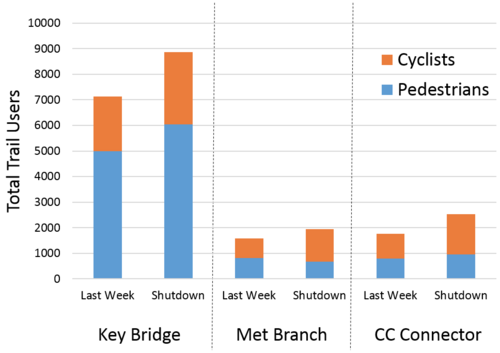When Metro closed, commuters took to the trails
When Metro closed on Wednesday, its 700,000 daily riders had to find a different way to get around. I compared data from Wednesday to the previous week to see how trail use changed.
Changes in trail use weren’t the same throughout the region, even when comparing corridors served by Metro. For example, on the Washington & Old Dominion and Custis Trails in Arlington, which combined run parallel to Route 66 and the Orange Line, trail use increased only modestly, by roughly 10% (basically
<100 more people on the Custis Trail during the AM peak, for example).
But on the trail segment connecting Crystal City to the Mount Vernon Trail, near the National Airport station (Blue/Yellow Line) and adjacent to the George Washington Parkway, trail use skyrocketed 44%, or over 300 additional travelers during just the AM peak. Most of the “new” trail users were cyclists, with cycling increasing by 62% from the previous week.
Thousands of additional pedestrians and cyclists crossed the Key Bridge between Arlington and DC, a 24% increase — even more than used the bridge during last year’s 4th of July festivities. Walking remained the dominant active mode on the bridge, though the cycling bump still outpaced the pedestrian bump (32% and 21%, respectively).
These data suggest it’s quite possible for people to change how they commute, with cycling in particular showing room for growth.
In DC, a final peek at the traffic monitors adds some additional nuance to the story. Pedestrian use of the Metropolitan Branch Trail
decreased 17%, suggesting that a chunk of those who usually walk on the trail are using it in order to access the Rhode Island and New York Avenue Metro stations. But cycling increased by a whopping 65%, suggestive of the critical importance of active transportation options in the urban core, where many households do not have access to a car.

